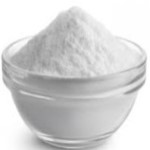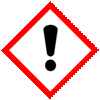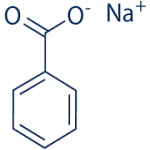CAS Number ---, Sodium Benzoate USP NF BP Ph Eur FCC Food Grade Manufacturers Exporters







CAS Number ---, Sodium Benzoate Manufacturer Exporter
For Properties Specifications of Sodium Benzoate Click Properties, Specifications of Sodium Benzoate Manufacturer.
For Uses of Sodium Benzoate Click Uses of Sodium Benzoate Manufacturer.
For For SDS MSDS Sheet of Sodium Benzoate Click SDS Safety Data Sheet MSDS Sheet of Sodium Benzoate Manufacturer.
The Properties and Specifications of Sodium Benzoate:
Sodium Benzoate BP Ph Eur Grade Specifications
C7H5NaO2
DEFINITION
Sodium benzenecarboxylate
Content: 99.0 per cent to 100.5 per cent (dried substance).
CHARACTERS
Appearance: White or almost white, crystalline or granular powder or flakes, slightly hygroscopic.
Solubility: Freely soluble in water, sparingly soluble in ethanol (90 per cent V/V).
IDENTIFICATION
A. It gives reactions of benzoates.
B. It gives reaction of sodium.
TESTS
Solution S: Dissolve 10.0 g in carbon dioxide-free water and dilute to 100 ml with the same solvent.
Appearance of solution: Solution S is clear and not more intensely coloured than reference solution.
Acidity or alkalinity: To 10 ml of solution S add 10 ml of carbon dioxide-free water and 0.2 ml of PhPh solution. Not more than 0.2 ml of 0.1 M sodium hydroxide or 0.1 M hydrochloric acid is required to change the colour of the indicator.
Halogenated compounds: Maximum 200 ppm for ionized chlorine and maximum 300 ppm for total chlorine.
Sodium Benzoate USP NF Grade Specifications
C7H5NaO2 --- 144.10
Benzoic acid, sodium salt.
Sodium Benzoate contains not less than 99.0 percent and not more than 100.5 percent of C7H5NaO2, calculated on the anhydrous basis.
Identification:
A: Infrared Absorption 197M , on the un-dried specimen.
B: It responds to the tests for Sodium and for Benzoate.
Alkalinity: Dissolve 2 g in 20 mL of hot water, and add 2 drops of PhPh TS: the pink color produced, if any, is discharged by the addition of 0.20 mL of 0.10 N sulfuric acid.
Water: not more than 1.5%.
Heavy metals: the limit is 0.001%.
Sodium Benzoate FCC Food Grade Specifications
C7H5NaO2 Formula weight 144.11
INS: 211 CAS 532-32-1
DESCRIPTION
Sodium Benzoate occurs as white granules, crystalline powder, or flakes. One gram dissolves in 2 mL of water, in 75 mL of alcohol, and in 50 mL of 90% alcohol.
Function: Preservative; antimicrobial agent.
REQUIREMENTS
Identification: A sample gives positive tests for Sodium and for Benzoate.
Assay: Not less than 99.0% and not more than 100.5% of C7H5NaO2, calculated on the anhydrous basis.
Alkalinity (as NaOH): Not more than 0.04%.
Lead: Not more than 2 mg/kg.
Water: Not more than 1.5%.
The Uses of Sodium Benzoate:
Sodium benzoate is used as a preservative in soft drinks to increase the acidity flavor and as a preservative to extend the shelf life. Sodium benzoate can be used as an anti-corrosive and preservative in a large variety of personal care products such as Mouthwash, Hair products, Sunscreen, Moisturizers, Serums, Baby wipes. Sodium benzoate is used as a preservative in some over-the-counter and prescription medications, particularly in liquid medicines like cough syrup. sodium benzoate is used to preserve food products with an acidic pH, such as fruit pulp and purees, jams, pickles, etc. It is used as a food preservative with an E number of E211. Sodium benzoate is widely used for preserving beverages, emulsions, foods, toiletries, pharmaceuticals, pastes, adhesives, cleaners, and several other products.
The MSDS-SDS Hazard Statement of Sodium Benzoate:
Sodium Benzoate SDS, Safety Data Sheet
MSDS Sheet, Material Safety Data Sheet 22-Jan-23
Section 1: Chemical Product and Company Identification
Product Name & Other Names: Sodium benzoate.
Synonym: Benzoic Acid, sodium salt or Benzoate of soda or Sodium benzoic acid.
CAS #: 532-32-1
EINECS EC Number: 208-534-8
Molecular Weight: 144.1
Chemical Formula: C7-H5-O2-Na
Relevant uses and uses advised against (if any): Industrial Manufacturing.
Section 2: Hazards Identification
GHS, Globally Harmonized System Classification in accordance with 29 CFR 1910
Classification according to Regulation (EC) No 1272/2008
Skin irritation (Category 3), H316
Eye irritation (Category 2A), H319
Labeling according to GHS USA & Regulation (EC) No 1272/2008
GHS Label Elements  Irritant |
Signal Words: Warning
Hazard statements:
H316: Causes mild skin irritation.
H319: Causes serious eye irritation.
Precautionary statements:
P262: Do not get in eyes, on skin, or on clothing.
P264: Wash skin thoroughly after handling.
P280: Wear protective gloves/protective clothing/eye protection/face protection.
P273: Avoid release to the environment.
P312: Call a POISON CENTER or doctor/physician if you feel unwell.
P332+313: If skin irritation occurs: Get medical advice/attention.
P302+P352: IF ON SKIN: Wash with plenty of soap and water.
P305+P351+P338: IF IN EYES: Rinse cautiously with water for several minutes. Remove contact lenses, if present and easy to do. Continue rinsing.
P337+P313: If eye irritation persists: Get medical advice/ attention.
Section32: Composition and Information on Ingredients
Product Name & Other Names: Sodium benzoate.
Synonym: Benzoic Acid, sodium salt or Benzoate of soda or Sodium benzoic acid.
CAS #: 532-32-1
EINECS EC Number: 208-534-8
Section 4: First Aid Measures
Always seek medical attention after first aid measures are provided.
Eye Contact: Check for and remove any contact lenses. In case of contact, immediately flush eyes with plenty of water for at least 15 minutes. Cold water may be used. Get medical attention.
Skin Contact: In case of contact, immediately flush skin with plenty of water. Cover the irritated skin with an emollient. Remove contaminated clothing and shoes. Cold water may be used. Wash clothing before reuse. Thoroughly clean shoes before reuse. Get medical attention.
Serious Skin Contact: Wash with a disinfectant soap and cover the contaminated skin with an anti-bacterial cream. Seek medical attention.
Inhalation: If Sodium benzoate is inhaled, remove to fresh air. If not breathing, give artificial respiration. If breathing is difficult, give oxygen. Get medical attention.
Ingestion: Do NOT induce vomiting unless directed to do so by medical personnel. Never give anything by mouth to an unconscious person. Loosen tight clothing such as a collar, tie, belt or waistband. Get medical attention if symptoms appear.
Section 5: Fire and Explosion Data
Flammability of the Product: May be combustible at high temperature.
Products of Combustion: Carbon oxides (CO, CO2).
Fire Hazards in Presence of Various Substances: Slightly flammable in presence of heat. Non-flammable in presence of shocks.
Explosion Hazards in Presence of Various Substances:
Risks of explosion of the product in presence of mechanical impact: Not available.
Slightly explosive in presence of open flames and sparks.
Fire Fighting Media and Instructions:
SMALL FIRE: Use DRY chemical powder.
LARGE FIRE: Use water spray, fog or foam. Do not use water jet.
Special Information: In the event of a fire, wear full protective clothing and NIOSH-approved self-contained breathing apparatus with full face piece operated in the pressure demand or other positive pressure mode. At high temperatures under fire conditions, it may produce toxic or irritating fumes. Fire-extinguishing work is done from the windward and the suitable fire-extinguishing method according to the surrounding situation is used.
Section 6: Accidental Release Measures
Personal precautions, protective equipment, and emergency procedures: Avoid breathing dust/fumes/gas/mist/vapors/spray. Use individual protective equipment (waterproof boots, suitable protective clothing, safety glasses, etc.). Do not approach facing the wind.
Environmental precautions: Do not let the product enter drains, soil, or water sources.
Methods and materials used for containment Cleanup procedures and Storage: Do not inhale dust, vapors, mist, or gas. Avoid dust formation. Contain spilled material. Cover with an inert, non-combustible absorbent material, (e.g. sand, earth, diatomaceous earth, vermiculite). Use a shovel to put the material into a convenient waste disposal container. Finish cleaning by spreading water on the contaminated surface and allow to evacuate as per law.
Section 7: Handling and Storage
Precautions for safe handling: Apply according to good manufacturing and industrial hygiene practices. Ensure proper ventilation. In case of insufficient ventilation, wear suitable respiratory equipment. Wash thoroughly after handling. Do not drink, eat, or smoke while handling. Avoid contact with skin, eyes, and clothing. Minimize dust generation. Avoid breathing dust/fumes/gas/mist/vapors/spray. Keep container tightly closed. Avoid ingestion and inhalation. Use individual protective equipment (waterproof boots, suitable protective clothing, safety glasses, etc.).
Conditions for safe storage, including any incompatibilities: Store in cool, dry, and ventilated area away from heat sources and protected from sunlight in tightly closed original container. Keep air contact to a minimum. Store protected from heat, sparks and ignition sources and incompatible materials. Avoid contact with skin and eyes. Avoid inhalation of dust/mist/vapor. Do not store with incompatible materials like strong oxidizing agents. Hygroscopic.
Section 8: Exposure Controls/Personal Protection
Engineering Controls: Use process enclosures, local exhaust ventilation, or other engineering controls to keep airborne levels below recommended exposure limits.
Exposure Limits: This product does not contain any hazardous materials with occupational exposure limits established by the region-specific regulatory bodies.
Ventilation System: A system of local and/or general exhaust is recommended to keep employee exposures as low as possible.
Personal Respirators (NIOSH Approved): For conditions of use where exposure to dust or mist is apparent and engineering controls are not feasible, a particulate respirator may be worn.
Skin Protection: Wear protective gloves and clean body-covering clothing.
Eye Protection: Use chemical safety goggles and/or full face shield where dusting or splashing of solutions is possible. Maintain eye wash fountain and quick-drench facilities in work area.
Other Control Measures: Maintain good housekeeping in work area. Handle in accordance with good industrial hygiene and safety practice.
Section 9: Physical and Chemical Properties
Physical state and appearance: White solid. (Granular solid. crystalline powder.)
Odor: Sodium benzoate is odorless.
Odor threshold: Not available.
Taste: Sweetish, astringent.
pH: Not available.
Relative density: Not available.
Melting Point: >300°C (572°F)
Initial boiling point and boiling range: Not available.
Flash point: Not available.
Auto-ignition temperature: Not available.
Decomposition temperature: Not available.
Upper/lower flammability or explosive limits: Not available.
Vapor pressure: Not available.
Vapor density: 4.97 (Air = 1)
Evaporation rate: Not available.
Flammability (solid, gas): Not available.
Partition coefficient: n-octanol/water: Not available.
Solubility: Easily soluble in cold water, hot water.
Viscosity: Not available.
Section 10: Stability and Reactivity Data
Stability: Sodium benzoate is stable.
Conditions of Instability: Excess heat, dust generation
Incompatibility with various substances: Reactive with oxidizing agents.
Corrosivity: Non-corrosive in presence of glass.
Special Remarks on Reactivity: Hygroscopic: Keep container tightly closed.
Special Remarks on Corrosivity: Not available.
Polymerization: Will not occur.
Section 11: Toxicological Information
Toxicity to Animals: Acute oral toxicity (LD50): 1600 mg/kg [Mouse].
Carcinogenicity: No component of this product present at levels greater than or equal to 0.1% is identified as probable, possible or confirmed human carcinogen by IARC.
Mutagenic Effects: Not available.
Developmental Toxicity: Not available.
Reproductive Effects: No information available.
Section 12: Ecological Information
Toxicity to fish: LC50 - Pimephales promelas (fathead minnow) - 484 mg/l - 96 h
Products of Biodegradation: Possibly hazardous short term degradation products are not likely. However, long term degradation products may arise.
Results of PBT and vPvB assessment: This substance/mixture contains no components considered to be either persistent, bioaccumulative and toxic (PBT), or very persistent and very bioaccumulative (vPvB) at levels of 0.1% or higher.
Section 13: Disposal Considerations
Waste Disposal: Waste must be disposed of in accordance with federal, state and local environmental control regulations.
Section 14: Transport Information
DOT USA, TDG Canada & ADR/RID Europe: Not controlled.
IATA/ICAO: Not controlled.
IMDG/IMO: Not controlled.
Section 15: Other Regulatory Information
USA Regulations:
SARA 311/312: Not applicable.
SARA 313: Not applicable.
Section 16 - Additional Information
DISCLAIMER: The information and recommendations set forth herein are presented in good faith and believed correct as of the date hereof. It is compiled from various sources and it is not necessarily all inclusive nor fully adequate in every circumstance. In addition, these suggestions should not be confused with nor followed in violation of applicable laws, regulations, rules or insurance requirements applicable. This MSDS sheet is intended only as a guide to the appropriate precautionary handling of the material by a properly trained person using this product. Individuals receiving the information must exercise their independent judgment in determining its appropriateness for a particular purpose.
Anmol Chemicals & Pharmaceuticals Pvt. Ltd. is an off-shoot of Anmol Chemicals Taloja. It is located in MIDC Taloja and it is manufacturing pharmaceutical grades of API, Excepients, Food grade and Reagent grade chemicals. Anmol Chemicals & Pharmaceuticals Pvt. Ltd. is a several decades old group of companies, engaged in manufacturing, supplying, distributing, wholesale supplies for actual users, retail or small pack supplies for research and development chemicals, fine and speciality chemicals, pharmaceutical excipients, mineral fortifiers in chemically pure, Analytical reagent grade, IP BP USP Ph Eur EP JP and other pharmaceutical grade monograph including FCC Food grade chemicals and Nutraceuticals, Mineral Fortifiers at best prices.

Sodium Benzoate Structure
CAS Number ---, Sodium Benzoate Manufacturer Exporter
ANMOL CHEMICALS & PHARMACEUTICALS Pvt. Ltd.
India, USA, Europe, UAE
TELEPHONE: +912223770100
Navi Mumbai, INDIA
e-mail: info(At the rate i.e. @)anmol.org
Copyright. 24-nov-24
We manufacture:
Glacial Acetic Acid Manufacturer
Dihydroxyaluminum Aminoacetate
Dihydroxyaluminum Sodium Carbonate
Calcium Gluceptate or Calcium Glucoheptonate

